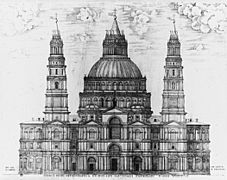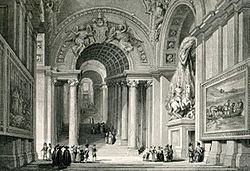Antonio da Sangallo the Younger facts for kids

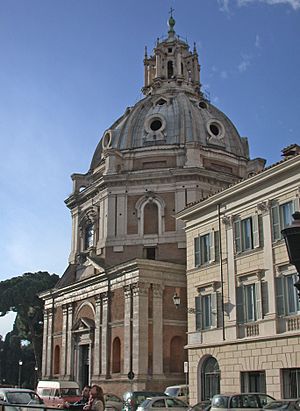
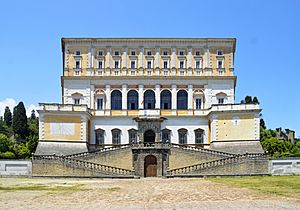
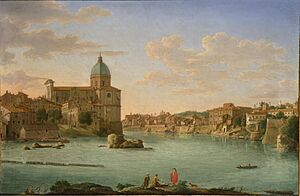
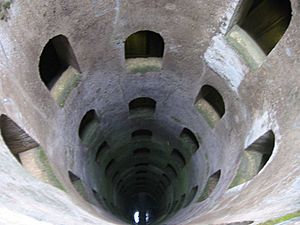
Antonio da Sangallo the Younger (born April 12, 1484 – died August 3, 1546) was a famous Italian architect. He lived during the exciting Renaissance period. He worked mostly in Rome and the areas controlled by the Pope, known as the Papal States.
One of his most important projects was helping to design St. Peter's Basilica in Vatican City. He was also a skilled engineer who helped fix and restore many buildings. Sangallo passed away in Terni, Italy, and was buried in St. Peter's Basilica.
Contents
Who Was Antonio da Sangallo the Younger?
Early Life and Learning
Antonio da Sangallo was born Antonio Cordiani in Florence, Italy. His father was Bartolomeo Piccioni. Antonio came from a family of talented builders. His grandfather, Francesco Giamberti, was a woodworker. His uncles, Giuliano da Sangallo and Antonio da Sangallo the Elder, were well-known architects.
Antonio followed his uncles to Rome to become an architect. He even took the family name "Sangallo." Instead of learning from an artist, he first trained with a carpenter. But soon, he became a student of the famous architect Donato Bramante.
Working with Bramante
As Bramante's helper, Sangallo drew many sketches. He was known for his talent and careful attention to detail. Because he was so good, Bramante gave Sangallo many projects to finish. He only gave Sangallo a basic idea of the design.
Eventually, Sangallo was put in charge of the Passetto di Borgo. This was a secret walkway between the Pope's apartments and the Castel Sant'Angelo. This project was not finished, but it helped Sangallo become known as a skilled architect.
Antonio's Own Projects
First Big Jobs in Rome
After moving to Rome, Sangallo quickly got a big job. In 1507, he was asked to design the church of Santa Maria di Loreto. His plan included a square first floor and an eight-sided second floor. These parts were built with stone and brick. The dome and top part were finished many years later.
Sangallo also caught the eye of Cardinal Alessandro Farnese. This cardinal later became Pope Paul III. Sangallo received many jobs from him. The most important was the Farnese Palace in Rome. This grand palace was not finished until after Sangallo died.
Sangallo also worked on other projects for the Farnese family. He designed a palace (which is now gone) and a church in the town of Gradoli. He also planned defenses for Capo di Monte and Caprarola. Caprarola later became a country home called the Villa Farnese.
Other Important Buildings
Besides the Farnese family, Sangallo had many other supporters in Rome. He designed the Palazzo Baldassini for Melchiore Baldassini. He also designed a tomb for Cardinal Jaume Serra i Cau.
Sangallo was one of several artists who designed the Villa Madama. This villa was for Cardinal Giulio de' Medici, who later became Pope Clement VII. Sangallo was in charge of the final design of the building itself.
Through these projects, Sangallo became known as a master architect in Rome. When Bramante died in 1514, Sangallo was chosen to help oversee the building of St. Peter's Basilica. He worked alongside Raphael and Giovanni Giocondo. Pope Leo X hired Sangallo for many jobs. He was not only an architect but also an engineer who fixed and saved many buildings.
Amazing Engineering Work
Building Foundations
Later, Sangallo was hired to build the foundation for the church of San Giovanni dei Fiorentini. This church was planned to extend into the Tiber River. This was a very hard job because the riverbank was not stable.
Sangallo successfully built the foundation. However, it cost so much money that there was not enough left to build the church itself. So, the church Sangallo designed was never built. Construction for the church only began much later, in 1583.
Repairing and Strengthening Buildings
Another project was the Basilica della Santa Casa in Loreto. This church had not been built very well. Its arches were cracking, and its foundation was weak. Sangallo redesigned the church and made its foundations strong. Some people say this was "the best that Antonio ever executed." This was especially true because it was harder to fix an old church than to build a new one.
Sangallo also did similar work on the Vatican loggias. These were open walkways that had become weak because of poor construction. His repairs are still strong today.
Military Fortifications and a Famous Well
Sangallo was also a skilled military architect. He worked on the defenses of many cities, such as Parma, Piacenza, Ancona, and Orvieto.
In Orvieto, Pope Clement VII asked him to build a well. This well is called Saint Patrick's Well. It is famous as an amazing piece of engineering. It has two spiral ramps that go around a central open shaft. This design allowed oxen carrying water to go down one ramp and up the other without turning around. Even though it is 175 feet deep, windows cut into the center keep the ramps well lit.
His last project was draining the Rieti Valley. This job was given to him by Pope Paul III. The swampy area was unhealthy, and Sangallo caught malaria. He died before he could finish his work.
Working on the Vatican and St. Peter's Basilica
Sangallo had a good relationship with the Popes. Because of this, he was always involved in designing and building St. Peter's Basilica. He worked on it from 1513 until at least 1536. As "capomaestro," he was in charge of the daily construction for many years. He also created a design for the basilica, and a wooden model of it still exists today.
-
The Sala Regia, designed by Sangallo for Pope Paul III.
-
The Scala Regia, with sculptures by Bernini.
Sangallo also worked a lot on the Vatican apartments. He built the Pauline Chapel and the Sala Regia. The Sala Regia is the entrance to the Sistine Chapel. He also built the Scala Regia, a grand staircase that is the main entrance to the Apostolic Palace. Some say Sangallo also changed the Sistine Chapel by making its roof higher, but exactly what he did is not clear.
Famous Works by Antonio da Sangallo the Younger
- Basilica della Santa Casa in Loreto.
- Cappella Paolina, the Sala Regia, and the Scala Regia in the Vatican.
- Old Fortress, Livorno.
- Palazzo Baldassini in Rome.
- Palazzo Farnese in Rome (1534–46), designed for Cardinal Alessandro Farnese.
- Palazzo Sacchetti in Rome; Sangallo designed this for himself.
- Saint Patrick's Well in Orvieto.
- Santa Maria di Loreto in Rome.
- San Giovanni dei Fiorentini in Rome.
- St. Peter's Basilica in Rome (he was the chief architect from 1520 on).
- Villa Madama in Rome (started 1518).
Death and What He Left Behind
Sangallo started designing the Palazzo Farnese in 1513. When Cardinal Alessandro Farnese became Pope Paul III in 1534, the palace design was made much larger. It is considered one of the most impressive Italian palaces of the 1500s.
In 1546, while the palace was being built, Pope Paul III was not happy with the design for the top edge (cornice). He held a competition for a new design. Michelangelo won this competition and oversaw the palace's completion. Sangallo died in Terni, Italy, not long after. He is buried in St. Peter's Basilica.
His biographer, Vasari, wrote that Antonio was "a most excellent architect." He said Sangallo deserved to be praised just as much as any other architect, old or new, because his works clearly showed his skill.
See also
 In Spanish: Antonio da Sangallo el Joven para niños
In Spanish: Antonio da Sangallo el Joven para niños


